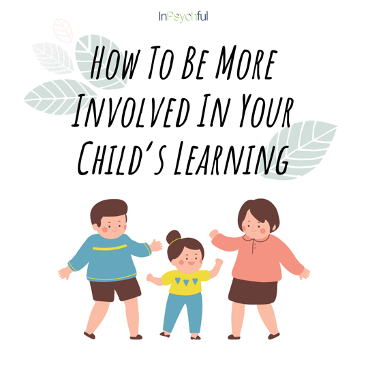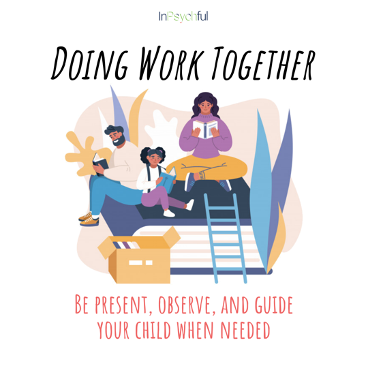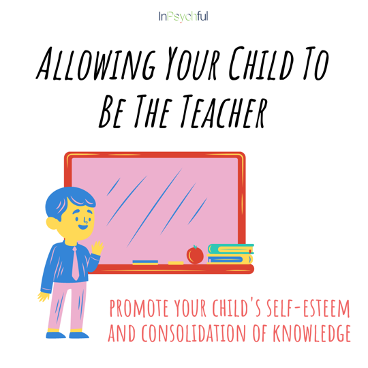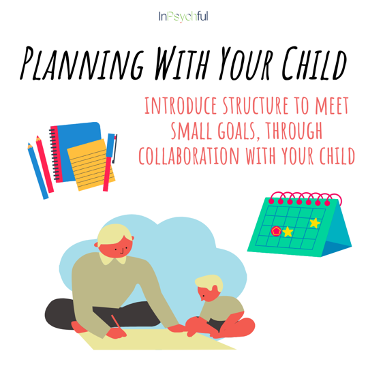“Let’s Do This Together!”
 When children embark on their academic journey, it is pivotal for parents to have a hands-on approach and personal involvement alongside them (Yeo, 2016). Parents are children’s main source of support: think of your child as a seedling and standard academic work as the soil. Parents are the fertiliser that helps the seedling grow tall and healthily, resilient against dangers and obstacles! It is not known to many that parental involvement in their child’s education is actually a big predictor of educational success (Henderson & Mapp, 2002).
When children embark on their academic journey, it is pivotal for parents to have a hands-on approach and personal involvement alongside them (Yeo, 2016). Parents are children’s main source of support: think of your child as a seedling and standard academic work as the soil. Parents are the fertiliser that helps the seedling grow tall and healthily, resilient against dangers and obstacles! It is not known to many that parental involvement in their child’s education is actually a big predictor of educational success (Henderson & Mapp, 2002).
However, do you sometimes feel as though you do not know how to be more connected with your child? Or feel lost in trying to help your child reach his or her full potential? It is very common for parents to feel this way. Many parents feel out of touch with their children, and sometimes even helpless (Reynolds, 2013). Parents may not fully understand children, and at times, children may also not understand that their parents have their best interests at heart. Helping your child succeed academically means being attuned to your child’s emotional, social, and academic needs and development.
Doing Work Together
Parents may be more accustomed to taking the hard approach with children, especially in Singapore where parents are more likely to be firmer and more strict (Chong, 2016). It may be common for parents to say, “you had better finish your homework before you watch TV” and then leave the room to do their own things.
One way that parents can be more present in their child’s learning would be to build up on existing discipline. Instead of merely setting a deadline for children, parents could sit down with children and not just watch, but guide and observe them as they do their work (The Center for Comprehensive School Reform and Improvement, 2012). Even for busy parents, you could be more present simply by sitting next to your child and doing your own work. Children often model their parent’s behaviour; thus, when they see you being disciplined in finishing your work, they will feel motivated too (Nauert, 2019). Furthermore, with you by your child’s side, you can easily extend your support when your child is having any difficulty, or if you spot your child having trouble. This creation of shared working time and space as parent and child can also help children to feel that they are not alone, but have Mummy and Daddy working alongside them (Khan, 2019).
Being a Part of Your Child’s Interests
Learning does not have to be solely confined to academic work – even in other aspects of your child’s life, you can see learning and development at play (Mcilroy, 2020). By encouraging holistic learning, you can promote a healthy work-life balance in your child.
Observe and be a part of your child’s hobbies and interests, and you can better understand what helps them to relax. Children can have many interests such as playing sports, listening to music, playing an instrument, computer or mobile games, and watching movies. When you see your child engaging in such activities, do not dismiss these activities, but understand how it brings joy and entertainment to your child (Garcia, 2020). Parents can also try to be involved by doing these activities with your child (White, 2018) – learning the sport together, watching movies as a family, or bringing them out to draw and paint (Garcia, 2020). These other forms of learning can help to promote greater hand-eye coordination, focus and emotion regulation, cognitive growth and creativity while helping children to recharge after studying for long periods of time (White, 2018).
Allowing Your Child To Be The Teacher
Children are used to being the student and the learner, at home or in school. How about giving your child the chance to be the teacher at home? You can set aside some time at the end of the day or the week and let your child ‘teach’ you what they have learnt in school. Give them a blank piece of paper or a whiteboard to consolidate their points and let them be creative in their ‘classroom’ set-up – make it a fun experience (Khan, 2019)!
By giving them the chance to ‘lead the class’, children are able to gain confidence in their own knowledge, articulation, expression, and also be aware of learning gaps that they have to bridge (Lim, 2016). Furthermore, children will become intrinsically motivated to study independently and be accurate and precise in the content that they teach. This gives them the chance to organise and process content knowledge, revise, and practice as well (Lim, 2016). When you are open to the idea of becoming the student, your child will see you as more approachable and present in their learning.
Planning with Your Child
Lastly, parents can introduce structure and assurance into children’s daily lives by planning with them. Parents and children can come up with weekly schedules to plan out study times, break times, family time, alone time, and so on; and take note of what should be done during these blocks of time (Dizik, 2020). This can help parents be aware of when they need to be involved and when they should let children have their personal space. Additionally, you and your child can list down weekly attainable goals that your child may want to achieve in school (Walker, 2015). For example, improve in spelling by five marks or finish one practice paper. Smaller, interspersed goals are generally more useful than big end-goals, because the completion of each small goal generates a sense of achievement and reward each time, thus delivering the positive effect of success regularly (Martin & Pear, 2019). This boosts the self-esteem and motivation of children even more greatly to continue meeting other small goals (Houston, 2020).
By creating a schedule together as parent and child, parents are displaying a good level of involvement with children. Parents are not forcefully dictating how children should spend their time, and neither are children being unsupervised, thus encouraging healthy collaboration between parent and child (Eyal, 2020). Children can also feel motivated and look forward to the more ‘fun blocks’ of time!
At first, it may seem difficult for parents to connect with children, especially when dealing with the concept of studies. However, with some effort, practice, and creativity, you will be able to gradually and naturally become a part of your child’s academic journey! As long as you are committing yourself to your child’s education and prioritise it, parental involvement should not be something to be afraid of. Learning, after all, is meant to be a fun and enriching part of both you and your child’s life.
Camellia Wong (MA), Kam Wing Shan
More Articles
References
Chong, S. A. (2016, August 22). Tiger mums, helicopter parents and modern child-rearing angst,. The Straits Times. https://www.straitstimes.com/opinion/tiger-mums-helicopter-parents-and-modern-child-rearing-angst
Dizik, A. (2020, April 5). How to work from home with your kids during coronavirus. BBC Worklife. https://www.bbc.com/worklife/article/20200401-how-to-work-from-home-with-your-kids-during-coronavirus
Eyal, N. C. (2020, July 20). Stanford psychology expert: This is the No. 1 skill parents need to teach their kidsâbut most don’t. CNBC. https://www.cnbc.com/2019/09/10/stanford-psychology-expert-biggest-parenting-mistake-is-not-teaching-kids-this-important-skill.html
Garcia, N. V. (2020, April 16). Why We Need to Encourage Our Children’s Interests—Even when They Seem Strange to Us. Sleeping Should Be Easy. https://sleepingshouldbeeasy.com/childrens-interests/
Henderson, A. T., & Mapp, K. L. (2002). A New Wave of Evidence: The Impact of School, Family, and Community Connections on Student Achievement. Annual Synthesis, 1. https://www.researchgate.net/publication/238728797_A_New_Wave_of_Evidence_The_Impact_of_School_Family_and_Community_Connections_on_Student_Achievement
Houston, E. (2020, September 1). What is Goal Setting and How to Do it Well. PositivePsychology.Com. https://positivepsychology.com/goal-setting/
Khan, A. (2019, December 21). How to Make Your Child Interested in Studying. FirstCry Parenting. https://parenting.firstcry.com/articles/20-tips-on-how-to-make-your-children-interested-in-study/
Lim, V. (2016, October 12). Do You Let Your Child Be Your Teacher? School Plus. https://schoolplus.com.sg/your-child-the-teacher/
Martin, G., & Pear, J. J. (2019). Behavior Modification: What It Is and How To Do It (11th ed.) [E-book]. Routledge. https://www.routledge.com/Behavior-Modification-What-It-Is-and-How-To-Do-It/Martin-Pear/p/book/9780815366546
Mcilroy, T. (2020, August 20). The Holistic Development of a Child During the Early Years. Empowered Parents. https://empoweredparents.co/holistic-development/
Nauert, R. (2019, June 15). Modeling Behavior for Children Has Long-Lasting Effects. PsychCentral. https://psychcentral.com/news/2018/05/27/modeling-behavior-for-children-has-long-lasting-effects/14139.html
Reynolds, M. (2013, September 18). Dad’s just not cool: Parents feel out of touch with their children. Express. https://www.express.co.uk/news/uk/437524/Dad-s-just-not-cool-Parents-feel-out-of-touch-with-their-children
The Center for Comprehensive School Reform and Improvement. (2012). Getting Parents Involved in Schools. Reading Rockets. https://www.readingrockets.org/article/getting-parents-involved-schools
Walker, T. (2015, April 29). The Enduring Importance of Parental Involvement. NEA Today. http://neatoday.org/2014/11/18/the-enduring-importance-of-parental-involvement-2/
White, S. (2018, September 3). Importance of Parental Involvement in Education. Dinner Table MBA. https://dinnertablemba.com/importance-of-parental-involvement-in-education/
Yeo, J. (2016, January 19). Parents’ support is key to success. The Straits Times. https://www.straitstimes.com/singapore/parents-support-is-key-to-success




